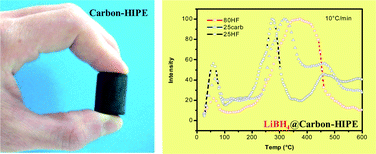Preparation of LiBH4@carbon micro–macrocellular foams: tuning hydrogen release through varying microporosity
Abstract
Microporous–macroporous carbononaceous monolith-type materials, prepared through a hard template method using

* Corresponding authors
a
Université de Bordeaux, Centre de Recherche Paul Pascal, UPR 8641 CNRS, 115 Avenue Albert Schweitzer, Pessac, France
E-mail:
backov@crpp-bordeaux.cnrs.fr
b
Laboratoire de Réactivité et Chimie des Solides, UMR 6007 CNRS, Université de Picardie Jules Verne, 33 Rue Saint Leu, Amiens, France
E-mail:
raphael.janot@u-picardie.fr
c Laboratoire de Chimie de la Matière Condensée de Paris, UMR 7574 CNRS, UPMC, Université Paris 06, Collège de France, 11 Place Marcelin Berthelot, Paris, France
d Université de Bordeaux, Institut des Sciences Moléculaires, UMR 5255 CNRS, 351 cours de la Libération, Talence, France
Microporous–macroporous carbononaceous monolith-type materials, prepared through a hard template method using

 Please wait while we load your content...
Something went wrong. Try again?
Please wait while we load your content...
Something went wrong. Try again?
N. Brun, R. Janot, C. Sanchez, H. Deleuze, C. Gervais, M. Morcrette and R. Backov, Energy Environ. Sci., 2010, 3, 824 DOI: 10.1039/C000858N
To request permission to reproduce material from this article, please go to the Copyright Clearance Center request page.
If you are an author contributing to an RSC publication, you do not need to request permission provided correct acknowledgement is given.
If you are the author of this article, you do not need to request permission to reproduce figures and diagrams provided correct acknowledgement is given. If you want to reproduce the whole article in a third-party publication (excluding your thesis/dissertation for which permission is not required) please go to the Copyright Clearance Center request page.
Read more about how to correctly acknowledge RSC content.
 Fetching data from CrossRef.
Fetching data from CrossRef.
This may take some time to load.
Loading related content
